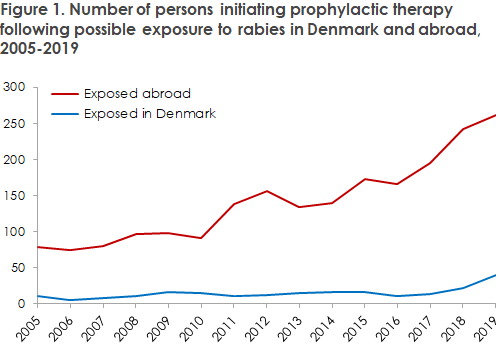No 18 - 2020
Report on rabies testing in Denmark in 2019
Report on rabies testing in Denmark in 2019
For a detailed description of rabies PEP and animals tested in Denmark in 2019, please see the annual report on rabies.
Illegally imported puppies
In 2019, a total of 11 persons initiated rabies treatment following dog bites, typically by puppies illegally imported from abroad, primarily from Serbia. It is the first time that more than a single annual case has been reported to Statens Serum Institut. It is important that Danish citizens are aware that illegally imported puppies may have rabies, and that they can transmit the infection several days before presenting with clear rabies symptoms.
More and more people are bitten by animals that may have rabies
Since 2010, the number of Danes who have been vaccinated abroad following possible exposure to rabies has more than doubled. In 2019, the number was 261, Figure 1. In 2019, exposure abroad constituted 87% of all exposed cases.
The number of bites in Denmark, primarily bat bites, also seems to be following an increasing trend; in 2017, a total of 13 persons initiated treatment following bat bites. By 2018, this number had increased to 21, and in 2019 to 28. Along with bites by illegally imported puppies, this means that the curve of persons who have initiated prophylactic treatment following exposure to rabies in Denmark is also increasing, Figure 1.

In 2019, a total of 300 persons were given treatment on suspicion of rabies after having been bitten by animals. The overwhelming majority (261) initiated treatment after having been bitten by animals abroad.
The majority of those initiating rabies post-exposure prophylaxis (PEP) following a bite abroad had become exposed in South-East Asia, followed by the Indian Subcontinent and Turkey.
Nobody developed the disease.
Rabies is preventable if you initiate timely treatment after possible exposure to the infection. In Denmark, possible exposure is almost exclusively due to bat bites, but it is important to be aware of the risk of infection from dogs that have been imported illegally from Eastern Europe or other areas where rabies may occur.
In case of bat bites in Denmark, the bat should be caught, if possible, and submitted for rabies testing by agreement with the Danish Veterinary and Food Administration. If a bat tests negative, the vaccination series is terminated.
Worldwide, 95% of all human rabies cases are associated with dog bites, and dog bites is the primary reason why Danish travellers receive prophylactic treatment. In recent years, several people have been bitten by monkeys abroad, but monkeys constitute a lower risk than dogs. If you are bitten by a monkey in a monkey park (which has occurred to several Danes), it is important to collect information about the monkeys in the park. In, e.g., Ubud Monkey Forrest on Bali, the park writes that monkeys are being monitored and that no rabies has been detected in its monkeys for the past 15 years, why the risk of exposure may be considered insignificant.
Among all of those exposed abroad in 2019, only eight persons had received Pre-Exposure Prophylaxis (PrEP) before embarking on their journey.
When giving advice prior to foreign travel, it is important to mention the risk of rabies associated with contact to animals. Travellers should be advised to limit contact to animals and to see a physician without delay in case of a bite. It is also important to inform travellers that human rabies immunoglobulin (HRIG) treatment is unavailable in many parts of the world.
It may be considered whether pre-exposure vaccination should be given, even in connection with short journeys to rabies-endemic countries. Such vaccination is particularly relevant if the nature of the journey will make it difficult to reach medical treatment within few days. Even so, it is important to remember that PrEP vaccinees must also receive a two-dose PEP vaccination schedule in case of exposure.
Rabies in animals
Classic rabies has not been observed in Denmark since 1982, while bat rabies is considered endemic. In 2019, a total of 18 animals from Denmark were tested for classic rabies and/or bat rabies, all of which tested negative. Classic rabies virus is endemic in Greenland, where Arctic foxes occasionally transmit the infection to other mammals. In 2019, no specimens were submitted for rabies testing from Greenland.
(A.K. Hvass, S. Cowan, Department of Infectious Disease Epidemiology and Prevention, T. B. Rasmussen, Department for Virus and Microbiological Special Diagnostics)